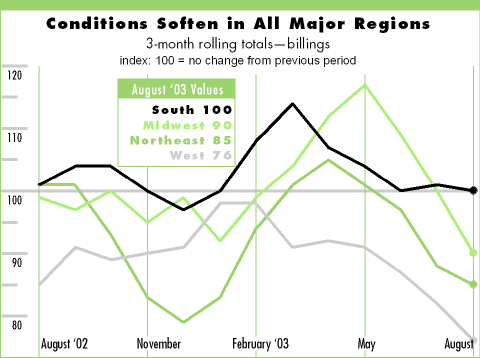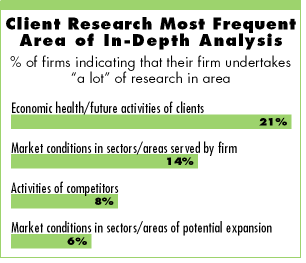

Billings Decline Again
in August at Architecture Firms
Only small share of firms active in business
research; client research tops list

WORK-ON-THE-BOARDS
by Kermit Baker, PhD, Hon. AIA
Chief Economist
 Billings
at architecture firms declined in August, with a drop even steeper than
that reported in July. While a one-month decline in billings at firms
can be dismissed as a blip, declines two months in a row certainly need
to be viewed with more concern. Inquiries for new work increased slightly
in August, but both the July and August increases in inquiries were well
below averages of the first six months of the year.
Billings
at architecture firms declined in August, with a drop even steeper than
that reported in July. While a one-month decline in billings at firms
can be dismissed as a blip, declines two months in a row certainly need
to be viewed with more concern. Inquiries for new work increased slightly
in August, but both the July and August increases in inquiries were well
below averages of the first six months of the year.
There was no major region of the country where firms reported billings increases in August, although firms in the South said billings were flat. Firms in the Northeast and West reported reasonably steep declines in billings. Firms in these regions also reported declines in inquiries in August, which is just as troubling as their steep drop in billings.
Billings were off more sharply at larger firms (those with over a million dollars a year in billings). At these firms, only 12 percent reported billings increases in August, while 30 percent reported declines. Residential firms reported an increase in billings in August; commercial/institutional and institutional firms reported steep declines. Curiously, residential firms reported a decline in inquiries, while commercial/industrial and institutional firms reported increases.

Yet, overall economy
is stronger
Oddly, the recent weakness in billings is coinciding with a general strengthening
in the broader economy. The manufacturing sector has shown steady improvement
for the past two quarters, and retail sales in the economy are increasing
at a 5 percent rate, the strongest growth since 2000. Housing starts in
August were above 1.8 million at an annual rate, the third straight month
starts have been at this level. The Economic Cycle Research Institute’s
leading index for the economy increased in August for the sixth straight
month, pointing to further improvement in the economy.
The decline in billings at architecture firms is in large measure due to state and local budget problems, which are cutting into the construction projects funded by municipalities. With payrolls continuing to shrink nationally, tax revenue is not rebounding as quickly as might be hoped, limiting the ability of state and local government to reverse their fiscal situation.
Limited resources
for research
Even though firms on average are much larger than they were a decade or
two ago, they still have limited resources to spend on business-related
research. This month, we asked our Work-on-the-Boards panel whether they
undertake a lot, some, or hardly any research in four key business areas.
 Client
research got the strongest response. Just over 20 percent of firms indicated
that they undertake a lot of research on the economic health and future
activities of current or potential clients. Fourteen percent of firms
undertake a lot of research on the markets or geographical areas that
they serve. Eight percent do a lot of research on their competitors, while
6 percent do a lot of research on construction sectors or areas under
consideration for potential expansion by their firm. As might be expected,
larger firms are much more likely to engage in business research. Firms
with annual billings of $5 million or more are just about twice as likely
as the average firm to do a lot of research in each of these areas.
Client
research got the strongest response. Just over 20 percent of firms indicated
that they undertake a lot of research on the economic health and future
activities of current or potential clients. Fourteen percent of firms
undertake a lot of research on the markets or geographical areas that
they serve. Eight percent do a lot of research on their competitors, while
6 percent do a lot of research on construction sectors or areas under
consideration for potential expansion by their firm. As might be expected,
larger firms are much more likely to engage in business research. Firms
with annual billings of $5 million or more are just about twice as likely
as the average firm to do a lot of research in each of these areas.
Copyright 2003 The American Institute of Architects.
All rights reserved. Home Page ![]()
 |
||
| This month, Work-on-the-Boards survey participants are saying: • Pressure on fees is still intense and we are seeing first-hand
design work being shipped electronically overseas, where production
can be done at lower costs. • The K–12 school market seems to be the strongest
market of all. But in this area--except for the blessed few—it’s
a work sector that is impossible to break into unless through merger,
acquisition, or a really strong alliance team.
• The market is still very soft in the public sector. The
typical project is much smaller than a few years ago.
|
||